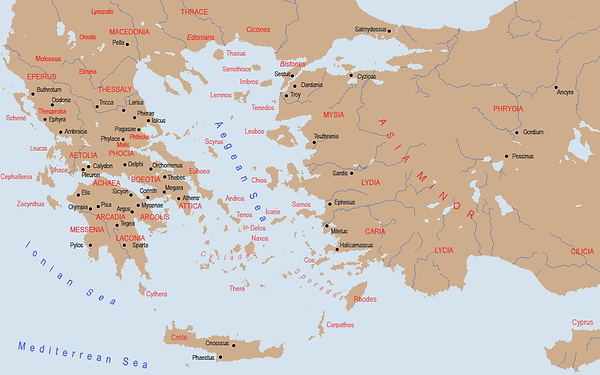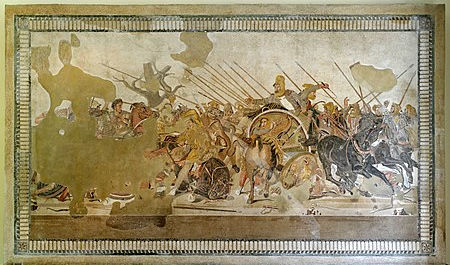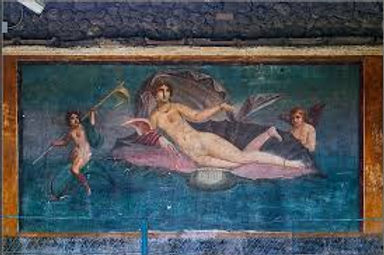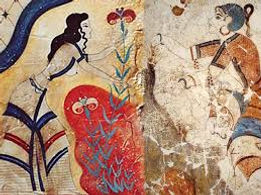<A>
Asiatic schools (of paintings): *
Ionia, although east of mainland Greece, had a huge impact on Greek culture. She boasted many distinguished men of letters and science, a distinct school of art & a famous Ionian School of philosophy. This latter school flourished between 700- 500 BC. Although Apelles comes after this great age of Ionia, he continues the tradition.

Apelles’ career spans the division between the Classical & Hellenistic ages. His work provides exemplars of the narrative realism admired by Greco-Roman connoisseurs. He had a taste for elaborate allegory & personification. Pliny the Elder rated him better then artists before & after his time. His work (none of which survive) include his renowned Alexander wielding a thunderbolt, one of the many he did of both Alexander & Philip. Another of his works was Aphrodite Anadyomene ("Aphrodite Rising from the Sea"), showing the goddess Venus. His influence was considerable & is evident in the Great Tomb at Vergina (painted between 336-317 BC), one of the major monuments of the Hellenistic age. The tomb contains a large wall painting depicting a royal lion hunt. The background was left white, landscape being indicated by a single tree & the ground line. The figures were painted in the fashion Apelles introduced, and there are sophisticated examples of optical fusion and light and shadow. A number of his paintings were taken to Rome (including Aphrodite Anadyomene) & placed on public display.

LEFT-Rrconstruction of a mosaic depiction of the Battle of Issus after a painting supposed to be by Apelles or Philoxenus of Eretria found in the House of the Faun at Pompeii.

LEFT- mural from Pompeii is believed to be based on Apelles' Venus Anadyomene, brought to Rome by Augustus.
<B>
Cnossus (new art): *
Minoan frescos reflect a sheer joy in fluid, naturalistic & graceful forms represented in an impressionistic manner. Many of the fresco fragments date from 1550 to 1450 BCE, when the Mycenaeans arrived. These are stylistically similar to earlier Minoan frescoes. Fresco secco (the application of paint, for details, onto a dry plaster) was used throughout as was the use of low relief in the plaster giving shallow3D effects. Colours used were black, red, white , yellow, blue & green. There are no examples of shading effects although sometimes the background colour changes whilst the foreground subjects remain unchanged. The Minoans adopted some of the Egyptians colour conventions. Male skin is usually red, female is white, and for metals: gold is yellow, silver is blue and bronze is red. The first frescos were limited to simple monochrome walls (usually red, sometimes black). With improved plaster and pigments, monumental Minoan architecture and influence from Egypt, fresco was used to decorate the walls, ceilings, wooden beams and floors in the palaces. Initially we find abstract shapes and geometric designs. Later they depict processions, rituals, animals & plants. Natural subjects included flowers (lilies, irises, crocuses, roses, ivy, reeds). The Minoans were one of the earliest cultures to paint natural landscapes devoid of humans. Animals were also commonly portrayed in their natural habitat (monkeys, birds, cats, goats, deer, sea urchins, dolphins, fish). Minoan frescoes were often framed with decorative borders of geometric designs; sometimes the principal fresco went beyond conventional boundaries such as corners, covering several walls, surrounding the viewer. Minoan frescoes influenced contemporary nearby cultures (e.g. the Cyclades, Mycenaean) and have been found as far afield as Tel el Dab’a in Egypt.

LEFT-fresco from palace at Knossos
<C>
Tell-el-Amarna (new art): *
Amarna art is a style adopted in the Amarna Period (during & just after the reign of Akhenaten, 1351–1334 BC), late 18th Dynasty, New Kingdom. Egyptian art was famously very slow to change but the Amarna style is a significant & sudden break from its predecessors. It is characterized by a sense of movement & activity in images, with figures having raised heads, figures overlapping, with busy & crowded scenes.

LEFT- the human body is portrayed differently; figures, always shown in profile on reliefs, are slender, swaying, with exaggerated extremities. Akhenaten is shown with distinctly feminine qualities (large hips, prominent breasts, larger stomach and thighs).